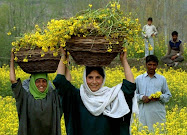Friday, January 9, 2009
Kashmir Cultural Heritage ---I
Kashmir is famous not only for its scenic beauty but also for its rich cultural heritage developed through thousands of years with its origin long ago when the water of the vast Satisar lake was drained out by the spiritual power of Great Maharishi Kahyap and the valley assumed its present shape. It might have taken a long time further to become habitable when the fame of the magnificent invigorating climate of Kashmir with her excellent spiritual environment spread far and wide. Soon it turned out to be the choicest spot for great seers, Rishis, Munees and highly awakened people worldwide for performing austerities and gain higher spiritual capacities in its cool environment away from the hustle and bustle of the common people. It’s only a long time further that the valley presented a picture of frequent settlements of people here and there but all of them the descendents of those great seers who had performed austerities for hundreds of years and achieved highest spiritual powers. Along with these settlements there were established many magical spots invested with great spiritual powers most of them the places where the ancient seers had performed their austerities, high on the mountain peaks or deep inside caves or in far away deep forests. Some of them were converted into highly venerated temples but most of them remained away from the public gaze and some of them found out incidentally by some stray visitor. It must have taken centuries for the valley to assume the position of a well developed society of a good population spread over the whole valley but the main concentration was on the banks of rivers and other water-bodies as all of them were mainly concerned with their spiritual pursuit which needed essentially to be nearer to the rivers and springs. Being the descendents of a chaste community of sages and saints here established certain set principles for chaste living according to pure Vedanta strictures and as per the local standards as the valley maintained minimum contacts with the rest of the world for its difficult location and weather conditions. Thus there developed a deeply religious life style with certain definite routine for the householders from morning till evening and any deviation from the set principles was taken very seriously. ------- (to be continued)
Subscribe to:
Post Comments (Atom)
.jpg)




No comments:
Post a Comment